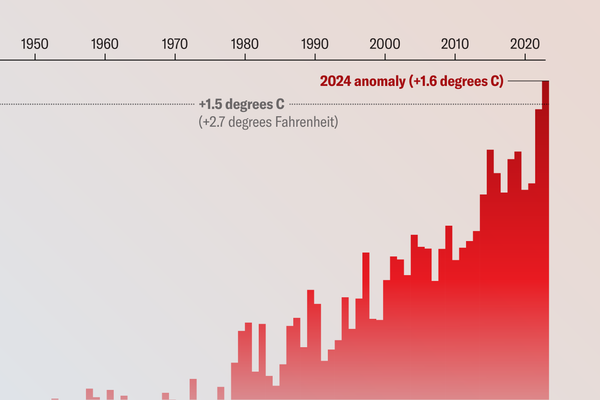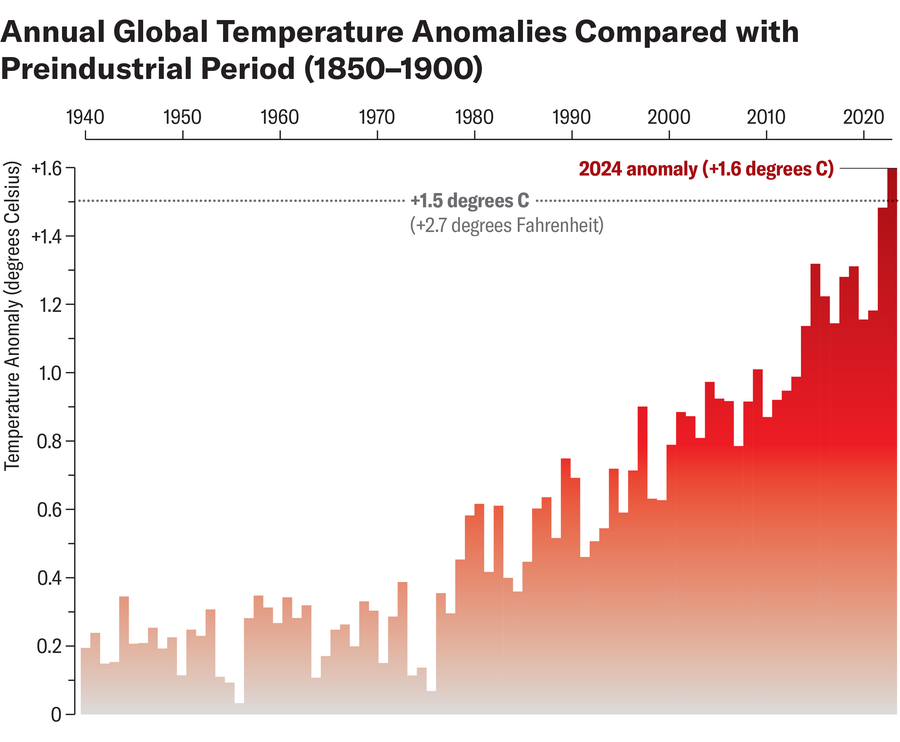January 9, 2025
Thank you for reading this post, don't forget to subscribe!3 min read
Earth Surpasses 1.5 Degrees C in Hottest Year on Record
The year 2024 was the hottest on record and the first to top 1.5 degrees Celsius of warming. All 10 of the hottest years have been in the past decade
By Andrea Thompson edited by Dean Visser

Amanda Montañez; Source: Copernicus Climate Change Service (data)
It’s official: 2024 is the hottest year on record—and the first to exceed 1.5 degrees Celsius (2.7 degrees Fahrenheit) above preindustrial temperatures. It’s another milestone that underscores how far the present climate has shifted from that of the past because of the continued burning of fossil fuels.
“All of the internationally produced global temperature datasets show that 2024 was the hottest year since records began in 1850,” said Carlo Buontempo, director of the European Union’s Copernicus Climate Change Service (C3S), in a news release.
Last year, which C3S measured at 1.6 degrees C (2.9 degrees F) above preindustrial temperatures, surpassed the record that was just set in 2023. That year had set the record by a wide margin in global temperature terms, registering 0.17 degree C (0.31 degree F) above the previous record holder, 2016, according to C3S. All of the 10 hottest years on record occurred in the past decade, according to C3S data.
On supporting science journalism
If you’re enjoying this article, consider supporting our award-winning journalism by subscribing. By purchasing a subscription you are helping to ensure the future of impactful stories about the discoveries and ideas shaping our world today.
Under the Paris climate accord, countries agreed to try to limit warming to under 1.5 degrees C and “well under” two degrees C (3.6 degrees F). That threshold hasn’t yet been breached; the accord considers the average over many years. But “we are now teetering on the edge of passing the 1.5°C level defined in the Paris Agreement and the average of the last two years is already above this level,” said Samantha Burgess, strategic lead for climate at the European Center for Medium-Range Weather Forecasts, C3S’s parent organization, in the recent news release.

Amanda Montañez; Source: Copernicus Climate Change Service (data)
Some of the superlative heat levels of the last two years were linked to the emergence of an El Niño—part of a natural climate phenomenon that features warmer than normal waters in the tropical Pacific Ocean. That warm water releases heat into the atmosphere, slightly raising global temperatures compared with a normal year and creating a cascade of effects on the world’s weather.
But the overwhelming majority of the current temperature rise from preindustrial times has been caused by the excess heat trapped by ever rising levels of greenhouse gases in the atmosphere. Last October the World Meteorological Organization (WMO) confirmed that globally averaged levels of carbon dioxide (the primary greenhouse gas) had reached a record high of 420 parts per million (ppm) in 2023. CO2 levels in the preindustrial period were around 280 ppm.
Reining in temperature rise—and mitigating climate-change-fueled disasters such as the recent fires in the Los Angeles area—will require substantial and rapid reduction of emissions around the entire planet. “The future is in our hands,” Buontempo said in the news release. “Swift and decisive action can still alter the trajectory of our future climate.”
Renewable energy use has grown quickly in recent years, but rising power demand has blunted efforts to reduce emissions. And political winds in the U.S. are not favorable for continuing the progress made under the Biden-Harris administration: President-elect Donald Trump has vowed to increase U.S. fossil-fuel production and to weaken federal rules that limit the emissions of planet-warming greenhouse gases.
Experts don’t expect 2025 to top last year’s record, in part because El Niño’s flip side, La Niña, has begun. La Niña features cooler than normal Pacific Ocean waters and tends to slightly cool global temperatures. But that cooling effect is relative, and this La Niña is expected to be a weak one. The U.K.’s Met Office predicts that 2025 will be among the three hottest years on record, just behind 2024 and 2023.
The year “2016 was an El Niño year and at the time it was the warmest year on record for global temperature,” said Adam Scaife of the Met Office in a news release issued by the agency last December. “In comparison to our forecast for 2025 though, 2016 is now looking decidedly cool.”

